This was published 5 years ago
La Paz: South America's most exciting city has world's highest cable car
By Ute Junker
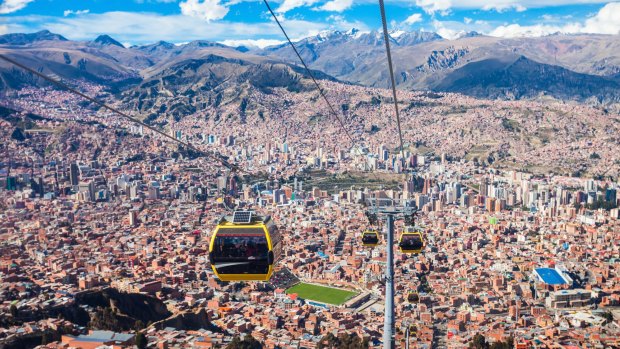
World's highest and longest cable car: La Paz, Bolivia.Credit: Shutterstock
In La Paz, the ride of your life costs just three bolivianos, or around 60 cents. That is the price of a ticket on the jauntily-named Mi Teleferico – "my cablecar" – La Paz's ultra-modern public transit system, which holds the title of both the world's longest and highest cable car system.
This mighty feat of engineering is a blessing for both locals and visitors, given the city's notoriously gridlocked streets. Since the first stage of Mi Teleferico opened in 2014, many of La Paz's workers have found their morning commute significantly easier, as they literally rise above the traffic. Tourists appreciate not just the speed of the journey, but also the fact that you can capture some amazing video as you travel from the city's highest points down to the valley floor or vice versa, the city unfurling beneath your feet.
And make no mistake; La Paz is one hell of a city. Surrounded by soaring mountains – at 3500 metres above sea level, this is the highest capital city in the world – the city cascades down steep cliff sides and across gentle slopes, and keeps on going. The only way you can really get a sense for its scale is to look down from above and gape at the way it clings to every slope and surface, all the way up to the Altiplano, the highest part of town. Four thousand metres above sea level, Altiplano has now officially been designated a separate city, its population of a million inhabitants counted separately to La Paz's official population of around 800,000.
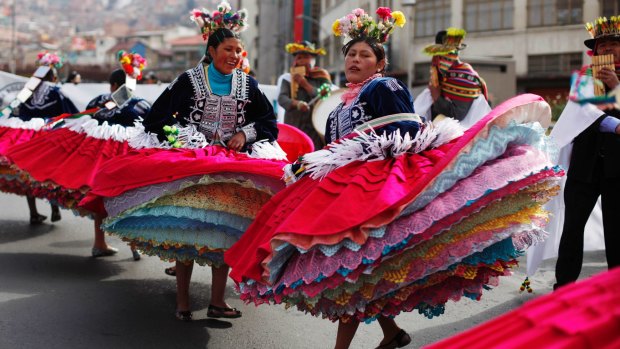
Aymara Indian dancers during the Intercultural Festival of Indigenous Music and Dance in La Paz.Credit: AAP
Looking down from on high, you also understand why the city seems to be in almost permanent gridlock. Roads not only have to switchback their way up steeply sloping hillsides; they also have to make abrupt turns to avoid soaring limestone stacks that seem to loom randomly out of the earth.
Convenient as the cable car is, however, you can't get a feel for La Paz without spending some time on its narrow streets. There has been a city here for 500 years, but most of the old town has disappeared under layers of modernity. You can get a sense for how it once looked in the beautifully restored Calle Jean, a gently curving street lined with historic buildings. Many are now home to chic boutiques and galleries, including one dedicated to the colourful canvases of Mamani Mamani, an artist who channels the aesthetic of the Aymari native people.
The buildings may be modern, but La Paz is a city where traditions linger – and not just in the miniature bowler hats which many local women wear. The sprawling Mercado de las Brujas, or witches' market, has been the place to buy traditional remedies for centuries. Look past the predictable stalls offering tourist tat and you will find plenty of traditional wares, including votive offerings and dried llama fetuses that, even today, are buried in the foundations of new buildings for luck.

A dish served at Gustu restaurant and bar in La Paz.Credit: Patricio Crooker
The market also offers plenty of food, Bolivians being a people who are always looking forward to their next meal. Not content with the three meals that most of us make do with, Bolivians add in additional repasts at odd hours. My particular favourite is saltena hour, which seems to happen somewhere around 11am. Saltenas – baked empanadas usually filled with beef, sometimes with chicken – are sold both at specialty stores and by wandering vendors, and you can fill up for just a couple of dollars. For the full experience, wash it down with fresh passionfruit juice.
When they don't have time for a snack, locals make do with drinks instead. One favourite, often sold by street vendors, is api morado, a smoothie-style drink made with purple corn, cinnamon and cloves.
Bolivia's capital has a few more surprises tucked up its sleeve, including some of the most remarkable – and least-known – ruins in Latin America. Just 70 kilometres from downtown La Paz, the ancient ruins of Tiwanaku are a fascinating window into a civilisation that predated – and greatly influenced – the Inca. In fact, the people of Tiwanaku would be mightily miffed at finding out that the Inca feature more heavily in the history books than they do.
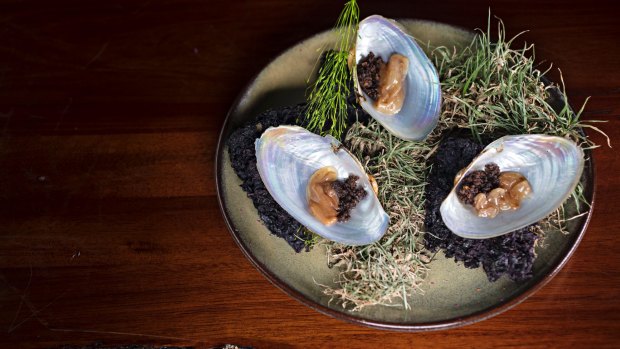
Gustu is La Paz's best place to eat. Credit: Patricio Crooker
Yes, the Inca ruled a vast empire that stretched across Bolivia, Peru and Chile, but the Tiwanaku managed the same feat much earlier. What's more, where Inca rule lasted barely a century, the Tiwanaku ruled for over 800 years. Along the way, they developed a distinctive, highly decorated style of monumental sculpture, polychrome pottery and a sophisticated agricultural system that allowed them to grow crops such as potatoes at high altitude, by planting them in raised beds surrounded by shallow canals, which helped keep off frost.
Like much else in Bolivia, the excavations at Tiwanaku are chronically underfunded. Most of the ruins still lie beneath the ground, but there is still plenty of see, with an on-site museum and a number of large-scale temples that have been reconstructed. The most remarkable thing about them is the huge blocks of stone that were used to build them. Each weighing up to 13 tonnes, the stones were transported across Lake Titicaca in reed boats and then dragged the final 10 kilometres to this site – proving that the inhabitants of this area have been thinking big for a long time.
Ute Junker travelled as a guest of LATAM Airlines and Adventure World Travel.
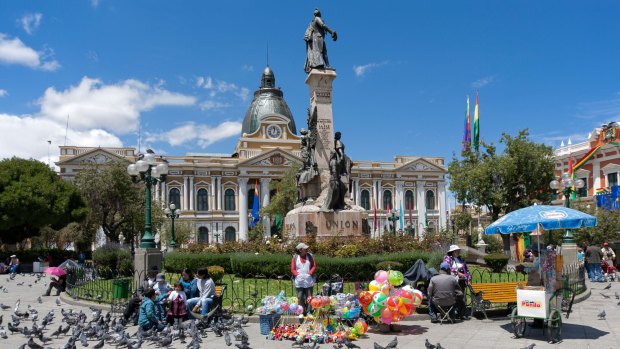
Plaza Murillo and National Congress in La Paz.Credit: Alamy
TRIP NOTES
MORE
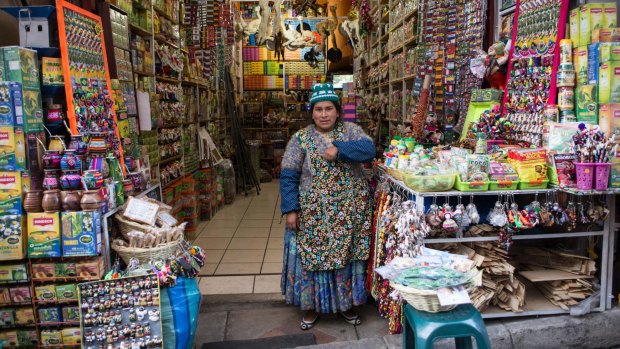
Cholita in the witches market, La Paz.Credit: Alamy
FLY
LATAM operates seven one-stop flights each week from Sydney to Santiago, Chile, with onward connections to Bolivia, and three non-stop flights a week from Melbourne to Santiago. For more information or to make a booking call LATAM reservations on 1800 126 038, visit your local travel agent or see www.latam.com
STAY
Atix Hotel is a stylish boutique property with compact rooms clad in native stone and wood, and artworks by Bolivian artist Gaston Ugalde. From $US140. See www.atixhotel.com
TOUR
Adventure World Travel's six-night Handpicked Bolivia Itinerary takes in La Paz, Lake Titicaca, Uyuni and the salt flats. From $3349 a person, including accommodation, meals as per the itinerary, sightseeing with a local English speaking guide, all transfers and flights as per itinerary. See www.adventureworld.com
LA PAZ HIGHLIGHTS
Don't leave La Paz without ticking these experiences off your list
WANDERING THROUGH THE VALLEY OF THE MOON
The last thing you would expect to find in a major metropolis is this maze-like canyon filled with eroded spires and buttresses. A walking path lets you admire this eye-catching landscape from several angles.
FEASTING ON STREET FOOD
Whether you are beating the mid-morning munchies with a steaming-hot saltena or scoffing a quick sandwich de chola, laden with roast pork and pickled vegetables, La Paz has plenty of tasty street food to keep you going.
GETTING LOST IN THE WITCHES' MARKET
In any other city, this sprawling collection of stalls, selling good luck charms and dried llama fetuses as well as ordinary household goods, would be a tourist trap. In La Paz, tourists are outnumbered by the locals trying to boost their luck.
DISCOVERING INDIGENOUS INGREDIENTS
It is a restaurant, a training school and a food laboratory: but most of all Gustu is La Paz's best place to eat. A sister restaurant to Copenhagen's famous NOMA, Gustu offers elegant degustation dinners featuring indigenous ingredients: think palm hearts, llama meat, wakataya flowers and tumbo fruit.
WATCHING TIME GO BACKWARDS
The Plaza Murillo is La Paz's power centre, home to the governor's palace and the Bolivian Congress as well as the city's cathedral. So couldn't they have got someone to fix the Congress clock, which appears to be running backwards? The quirky clock is actually a political statement from President Evo Morales, demonstrating his desire to do things differently.
See also: The world's nine ugliest cities (that are actually awesome)
Sign up for the Traveller Deals newsletter
Get exclusive travel deals delivered straight to your inbox. Sign up now.